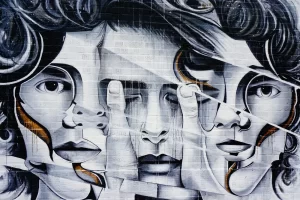Graffiti and murals are two prominent entities of visual art that are unique to particular environments. It is almost impossible to find a similar piece in two separate environments as these pieces are used to communicate the culture and beliefs of a particular people. Additionally, they are perceived as criminal, yet they seek to express the idea of creative souls in a given neighbourhood. Both graffiti and murals share a significant part in the history of public expression; they can be used together or separately to convey a particular idea by the artist.
The most notable difference between graffiti and murals is exhibited in their purpose and how people within the society perceive them. According to Olaluwoye and Ogungbemi (2020), graffiti is perceived as a rebellious act, an expression of individual identity or social protest, and is typically unsanctioned. The earliest forms of graffiti can be traced back to the 1970s in New York City, among the marginalized societies. The government believed that these individuals opted to express their frustrations and living situations, hence opted to criminalize graffiti (Hána and Šel, 2022). Thereafter, graffiti was considered a form of vandalism as most of them are done on public property without relevant permissions from the authorities.
On the other hand, murals are pieces that must be commissioned by society or government before they are permitted on public places. They have a deep historical nature as they seek to communicate ideas that are currently happening in the region (Farkić and Kennell, 2021). Murals have been used throughout history to communicate political, religious, or cultural narratives. Famous muralists, such as Diego Rivera, have created large-scale works that are celebrated for their artistic and cultural value. The intention behind a mural is usually to engage and inspire the community, often in a way that is more socially acceptable and respected than graffiti.
While both graffiti and murals are public art, they tend to differ stylistically. Graffiti is spontaneous and tends to be vibrant while murals must undergo commissioning and also stick to a specific regulates style. Since they are commissioned, murals must have a tag of the artist and even the date of creation (Farkić and Kennell, 2021). They are typically more structured and planned. They often depict realistic images or narratives, utilizing traditional painting techniques and requiring extensive time and preparation. However, graffiti remain random and their artists never reveal their identities. Some of them may use pseudo names to ensure that their work is not stolen by other individuals.
Despite their differences, graffiti and murals share key similarities. Both are forms of public expression that give a voice to individuals and communities. Thy serve as an expression of social or political issues and can be powerful tools for cultural commentary. Both graffiti and murals transform public spaces into canvases for artistic dialogue, offering alternative perspectives that might not be represented in mainstream art.
While graffiti and murals differ in their purpose and societal acceptance, they both share a common goal of public expression and cultural significance, enriching the urban landscape with diverse artistic voices.
Olaluwoye, L., & Ogungbemi, O. D. (2020). A sociolinguistic investigation of toilet graffiti among male students of the University of Ibadan. NIU Journal of Social Sciences, 5(4), 167-175.
Hána, D., & Šel, J. (2022). Political graffiti in the political symbolic space of Prague, Czechia. Urban Research & Practice, 15(5), 679-698.
Farkić, J., & Kennell, J. (2021). Consuming dark sites via street art: Murals at Chernobyl. Annals of Tourism Research, 90, 103256.




